Birch Barbara M. English L2 Reading: Getting to the Bottom
Подождите немного. Документ загружается.

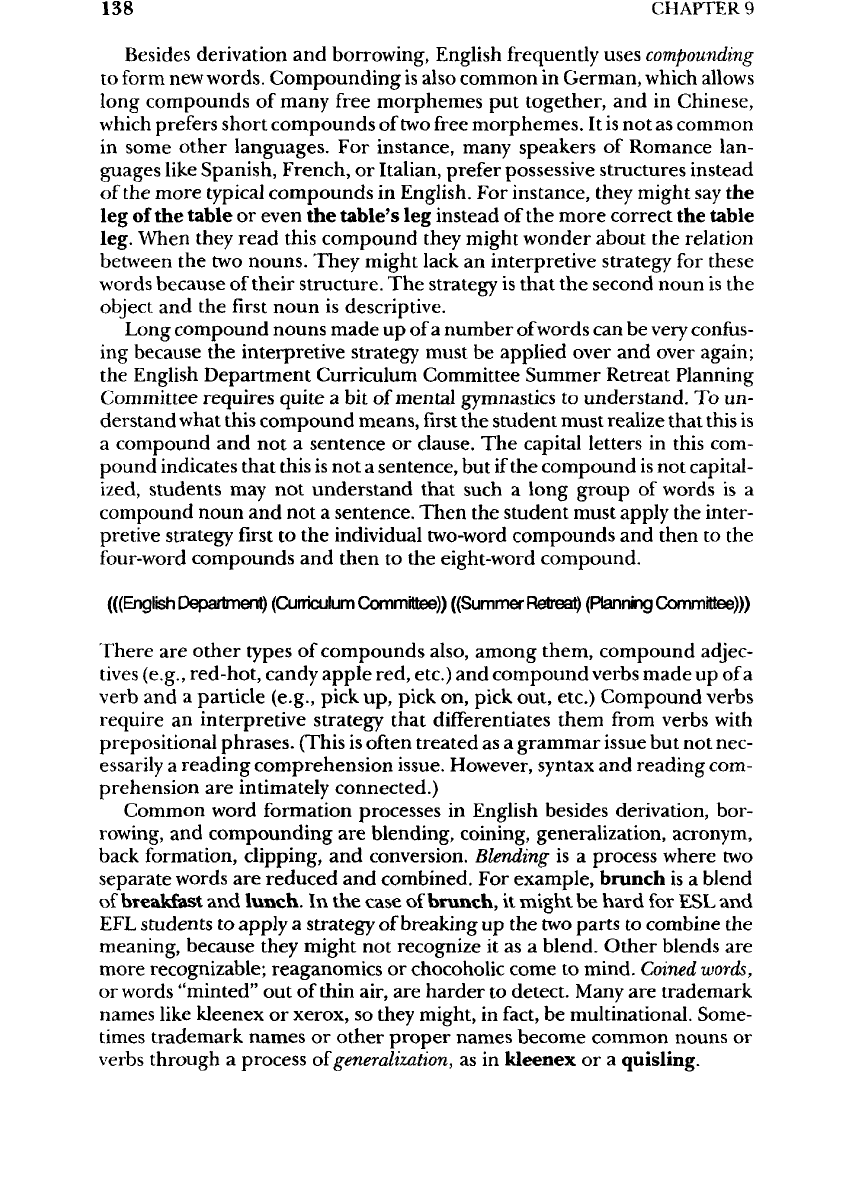
138
CHAPTER
9
Besides
derivation
and
borrowing, English frequently uses
compounding
to
form
new
words. Compounding
is
also common
in
German, which
allows
long compounds
of
many free morphemes
put
together,
and in
Chinese,
which
prefers short compounds
of
two
free
morphemes.
It is not as
common
in
some other languages.
For
instance, many speakers
of
Romance lan-
guages like Spanish, French,
or
Italian, prefer possessive structures instead
of
the
more typical compounds
in
English.
For
instance, they might
say the
leg of the
table
or
even
the
table's
leg
instead
of the
more
correct
the
table
leg. When they read this compound they might wonder about
the
relation
between
the two
nouns. They might lack
an
interpretive strategy
for
these
words
because
of
their
structure.
The
strategy
is
that
the
second noun
is the
object
and the
first
noun
is
descriptive.
Long compound nouns made
up of a
number
of
words
can be
very
confus-
ing
because
the
interpretive strategy must
be
applied over
and
over again;
the
English Department Curriculum Committee Summer Retreat Planning
Committee
requires quite
a bit of
mental gymnastics
to
understand.
To un-
derstand what this compound means,
first the
student must realize that this
is
a
compound
and not a
sentence
or
clause.
The
capital letters
in
this
com-
pound indicates that this
is not a
sentence,
but if the
compound
is not
capital-
ized,
students
may not
understand that such
a
long group
of
words
is a
compound noun
and not a
sentence.
Then
the
student must apply
the
inter-
pretive strategy
first to the
individual two-word compounds
and
then
to the
four-word
compounds
and
then
to the
eight-word compound.
(((English
Department)
(Curriculum
Committee))
((Summer
Retreat)
(Planning
Committee)))
There
are
other types
of
compounds also, among them, compound
adjec-
tives
(e.g., red-hot, candy
apple
red, etc.)
and
compound verbs made
up of a
verb
and a
particle
(e.g., pick
up,
pick
on,
pick out, etc.) Compound verbs
require
an
interpretive strategy that differentiates them
from
verbs
with
prepositional phrases. (This
is
often treated
as a
grammar issue
but not
nec-
essarily
a
reading comprehension issue. However, syntax
and
reading com-
prehension
are
intimately connected.)
Common word formation processes
in
English besides derivation, bor-
rowing,
and
compounding
are
blending, coining, generalization, acronym,
back
formation, clipping,
and
conversion.
Blending
is a
process where
two
separate words
are
reduced
and
combined.
For
example, brunch
is a
blend
of
breakfast
and
lunch.
In the
case
of
brunch,
it
might
be
hard
for
ESL
and
EFL
students
to
apply
a
strategy
of
breaking
up the two
parts
to
combine
the
meaning,
because they might
not
recognize
it as a
blend.
Other
blends
are
more recognizable; reaganomics
or
chocoholic come
to
mind.
Coined
words,
or
words "minted"
out of
thin air,
are
harder
to
detect.
Many
are
trademark
names
like
kleenex
or
xerox,
so
they might,
in
fact,
be
multinational. Some-
times
trademark names
or
other
proper names become common nouns
or
verbs
through
a
process
of
generalization,
as in
kleenex
or a
quisling.
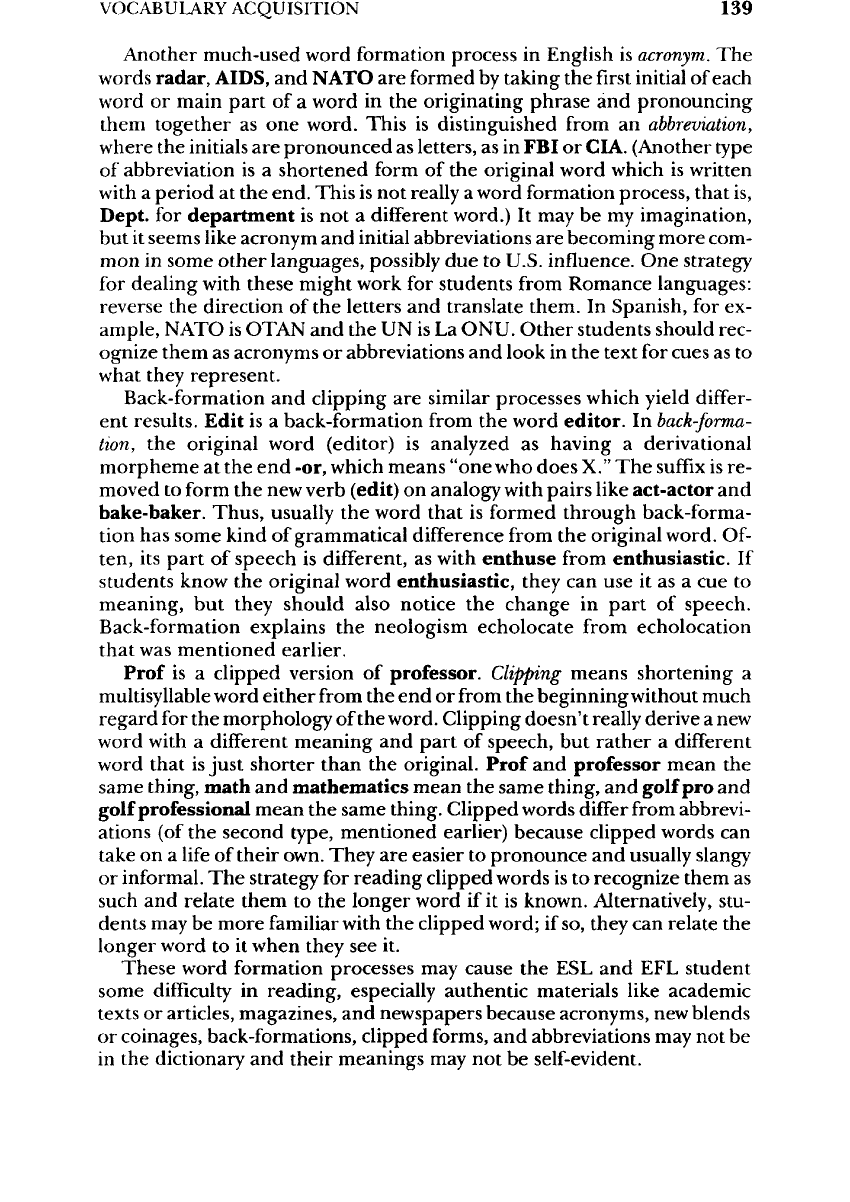
VOCABULARY
ACQUISITION
139
Another much-used word formation process
in
English
is
acronym.
The
words
radar, AIDS,
and
NATO
are
formed
by
taking
the first
initial
of
each
word
or
main part
of a
word
in the
originating phrase
and
pronouncing
them
together
as one
word.
This
is
distinguished
from
an
abbreviation,
where
the
initials
are
pronounced
as
letters,
as in FBI or
CIA. (Another type
of
abbreviation
is a
shortened form
of the
original word which
is
written
with
a
period
at the
end.
This
is not
really
a
word formation process, that
is,
Dept.
for
department
is not a
different
word.)
It may be my
imagination,
but
it
seems like acronym
and
initial abbreviations
are
becoming more com-
mon in
some
other
languages, possibly
due to
U.S. influence.
One
strategy
for
dealing
with
these might work
for
students
from
Romance languages:
reverse
the
direction
of the
letters
and
translate them.
In
Spanish,
for ex-
ample,
NATO
is
OTAN
and the UN is La
ONU. Other students should rec-
ognize them
as
acronyms
or
abbreviations
and
look
in the
text
for
cues
as to
what
they represent.
Back-formation
and
clipping
are
similar processes which yield
differ-
ent
results. Edit
is a
back-formation
from
the
word editor.
In
back-forma-
tion,
the
original word (editor)
is
analyzed
as
having
a
derivational
morpheme
at the end
-or, which means "one
who
does
X." The
suffix
is re-
moved
to
form
the new
verb (edit)
on
analogy
with
pairs like act-actor
and
bake-baker.
Thus, usually
the
word that
is
formed through back-forma-
tion
has
some kind
of
grammatical difference
from
the
original word.
Of-
ten,
its
part
of
speech
is
different,
as
with
enthuse
from enthusiastic.
If
students
know
the
original word enthusiastic, they
can use it as a cue to
meaning,
but
they should also notice
the
change
in
part
of
speech.
Back-formation
explains
the
neologism echolocate from echolocation
that
was
mentioned earlier.
Prof
is a
clipped version
of
professor.
Clipping
means shortening
a
multisyllable
word either from
the end or
from
the
beginning
without
much
regard
for the
morphology
of the
word. Clipping doesn't really derive
a new
word
with
a
different
meaning
and
part
of
speech,
but
rather
a
different
word
that
is
just shorter than
the
original. Prof
and
professor mean
the
same thing, math
and
mathematics mean
the
same thing,
and
golf
pro and
golf
professional mean
the
same thing. Clipped words
differ
from
abbrevi-
ations
(of the
second type, mentioned earlier) because clipped words
can
take
on a
life
of
their own. They
are
easier
to
pronounce
and
usually slangy
or
informal.
The
strategy
for
reading clipped words
is to
recognize them
as
such
and
relate them
to the
longer word
if it is
known. Alternatively, stu-
dents
may be
more familiar with
the
clipped word;
if so,
they
can
relate
the
longer word
to it
when they
see it.
These
word formation processes
may
cause
the ESL and EFL
student
some
difficulty
in
reading, especially authentic materials like academic
texts
or
articles, magazines,
and
newspapers because acronyms,
new
blends
or
coinages, back-formations, clipped forms,
and
abbreviations
may not be
in
the
dictionary
and
their meanings
may not be
self-evident.

140
CHAPTER
9
The use of
metaphor
to
refer
to an
object, although technically
not a
word
formation process,
can
also create challenges
for
readers.
A
metaphor
is
a
figure of
speech
in
which
a
word which denotes
one
thing
is
used
in
place
of
another
to
suggest
a
likeness
or
similarity between
the two
things. Using
the
word
ice
instead
of
diamond
is a
metaphor
drawing
on our
awareness
that
diamonds
and ice
have similarities
in
appearance.
If a
waitress uses
the
term
ham
sandwich
to
refer
to a
customer
in the
sentence, "The
ham
sand-
wich
left
without paying,"
she is
using
a
figure
of
speech drawing
on the as-
sociated
concepts
of the
individual customer
and
what
he
ate. This example
of
metonymy,
where
a
word meaning
an
attribute
or a
part (the sandwich)
is
used
in
place
of
another
which
is the
whole (the customer),
is a
specific
type
of
metaphor.
Understanding
a
metaphor requires reasoning
by
analogy.
To
under-
stand
the use of
that
old
goat
in
reference
to an
elderly character, students
must
first
know that
goat
is
being used
to
refer
to the
character
and not
some
extraneous animal
in the
story.
They
must know what
a
goat
is and
what
properties could
be
shared
by a
goat
and an
elderly
man
(e.g., smelly, shaggy,
stubborn, reclusive, bossy, stringy,
and
thin)
to
successfully
understand
the
analogy.
Native-speaking
readers
can
usually understand
figures of
speech
because
the
meaning associations stored
in
semantic memory
are not
self-contained
and
isolated
one
from
another.
Rather, they
are
widespread
networks
of
interconnected concepts
and
associations (called schemas) which
have
been
built
up
through
the
years
as we
have learned about words, culture,
and
the
world. Thus, when native-speaking
readers
come across
a figure of
speech,
the
associations evoked allow
the
readers
to
understand what
the
writer
is
trying
to
say.
ESL and EFL
readers
may not
have
the
stored cultural
concepts
and
associations
to
understand common metaphors
in
English,
or
they
may
understand them
in an
unintended
way.
In
addition, comprehen-
sion
of
metaphor
is not
universal.
It is
learned
and
developmental,
and as
such,
it is
reasonable
to
expect cultural variation
in its use and
interpretation.
Metaphors can, through repetition, become
so
conventionalized that
they
lose their special status
as a figure of
speech
and
become merely cases
of
polysemy.
Polysemy
is not a
word formation process,
but it can be
confus-
ing.
It
refers
to any
words which have
more
than
one
meaning.
In
some
cases
of
polysemy,
the
meanings
of the
word
are
clearly related
to
each
other
and yet we are
quite sure that
the
meanings
are
different.
An
example
of
this would
be the use of the
word
mouse,
which
began
as a
metaphor
to
describe
the
computer part because
of its
resemblance
to the
animal
in
color, size,
and
shape,
and
possession
of a
tail. Now, many would probably
say
that
the
word
mouse
has two
clearly different meanings equal
in
impor-
tance:
the
small animal
and the
computer
part.
It is
ceasing
to be a
meta-
phor
and
becoming
a
case
of
polysemy.
In
cases with
a
longer historical background,
the
meanings
may
seem
more distant
from
each other,
but we
would
agree,
still,
that they
are re-
lated.
An
example
is the
word point:
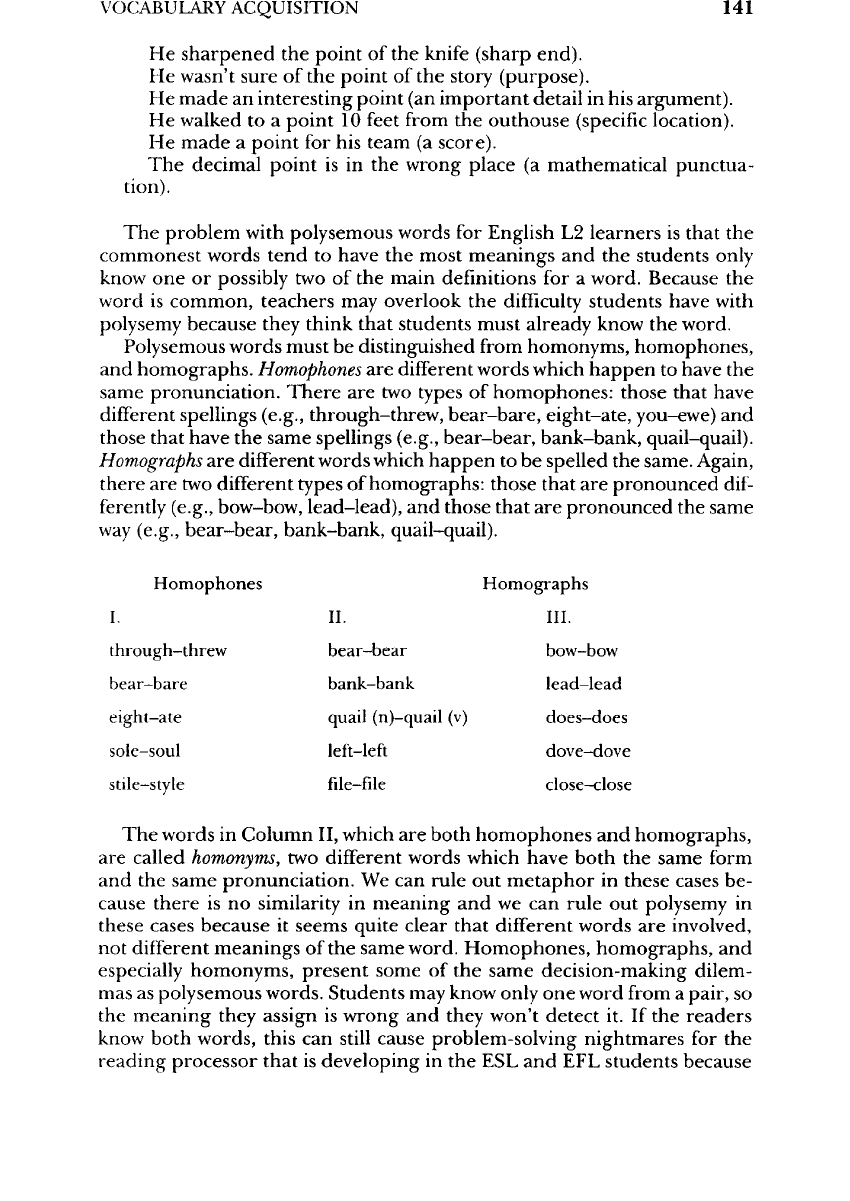
VOCABULARY
ACQUISITION
141
He
sharpened
the
point
of the
knife
(sharp end).
He
wasn't sure
of the
point
of the
story (purpose).
He
made
an
interesting point
(an
important detail
in his
argument).
He
walked
to a
point
10
feet
from
the
outhouse
(specific
location).
He
made
a
point
for his
team
(a
score).
The
decimal point
is in the
wrong place
(a
mathematical punctua-
tion).
The
problem with polysemous words
for
English
L2
learners
is
that
the
commonest words tend
to
have
the
most meanings
and the
students
only
know
one or
possibly
two of the
main definitions
for a
word. Because
the
word
is
common, teachers
may
overlook
the
difficulty
students have
with
polysemy
because they think that students must already know
the
word.
Polysemous
words must
be
distinguished
from
homonyms, homophones,
and
homographs.
Homophones
are
different
words which happen
to
have
the
same pronunciation.
There
are two
types
of
homophones: those that have
different
spellings (e.g., through-threw,
bear-bare,
eight-ate,
you-ewe)
and
those
that have
the
same spellings (e.g.,
bear-bear,
bank-bank, quail-quail).
Homographs
are
different
words which happen
to be
spelled
the
same. Again,
there
are two
different
types
of
homographs: those that
are
pronounced dif-
ferently
(e.g., bow-bow,
lead-lead),
and
those that
are
pronounced
the
same
way
(e.g.,
bear-bear,
bank-bank, quail-quail).
Homophones
Homographs
I.
II.
III.
through-threw
bear-bear
bow-bow
bear-bare
bank-bank
lead-lead
eight-ate
quail (n)-quail
(v)
does-does
sole-soul
left-left
dove-dove
stile-style
file-file
close-close
The
words
in
Column
II,
which
are
both homophones
and
homographs,
are
called
homonyms,
two
different
words which have both
the
same
form
and
the
same pronunciation.
We can
rule
out
metaphor
in
these cases
be-
cause
there
is no
similarity
in
meaning
and we can
rule
out
polysemy
in
these
cases because
it
seems quite clear that
different
words
are
involved,
not
different
meanings
of the
same word. Homophones, homographs,
and
especially
homonyms, present some
of the
same decision-making dilem-
mas
as
polysemous words. Students
may
know only
one
word
from
a
pair,
so
the
meaning they assign
is
wrong
and
they won't detect
it. If the
readers
know
both words, this
can
still
cause problem-solving nightmares
for the
reading
processor that
is
developing
in the ESL and EFL
students because
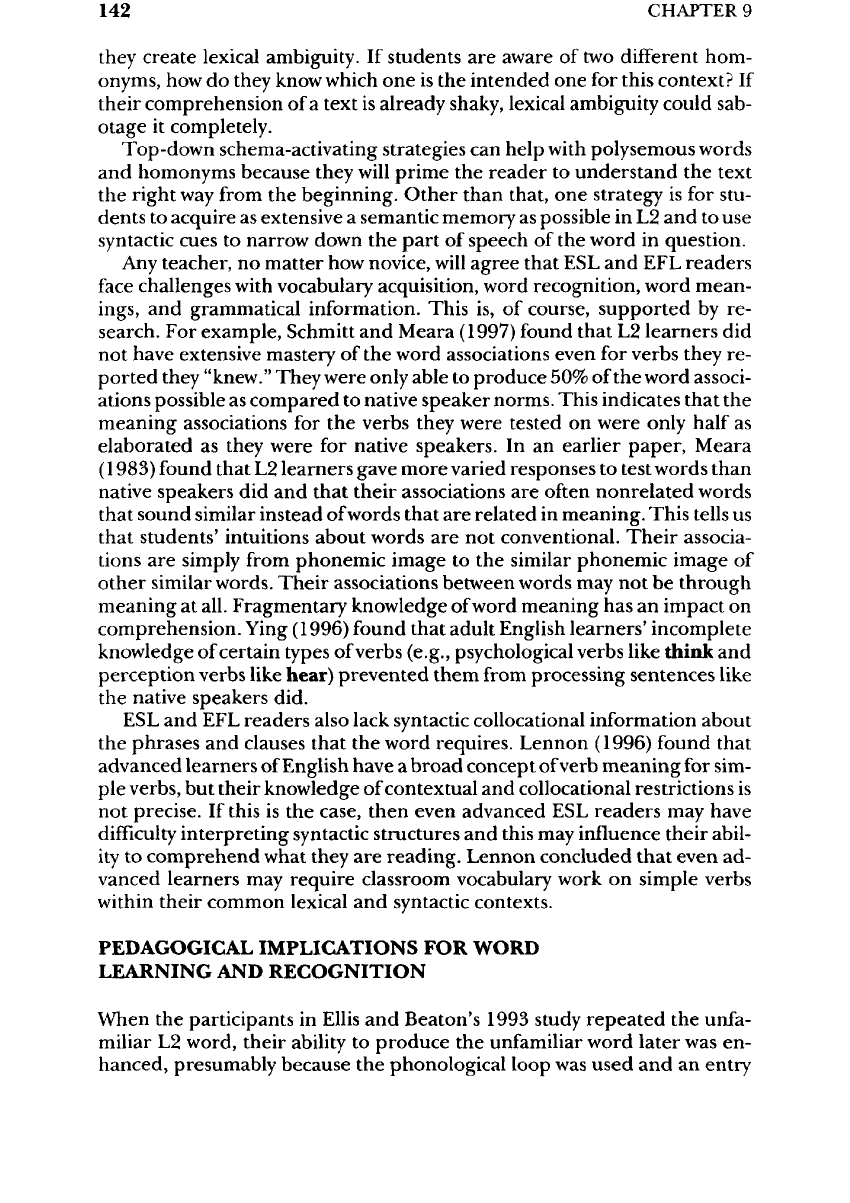
142
CHAPTER
9
they
create lexical ambiguity.
If
students
are
aware
of two
different
hom-
onyms,
how do
they know which
one is the
intended
one for
this context?
If
their comprehension
of a
text
is
already
shaky,
lexical ambiguity could sab-
otage
it
completely.
Top-down schema-activating strategies
can
help
with
polysemous
words
and
homonyms because they
will
prime
the
reader
to
understand
the
text
the
right
way
from
the
beginning. Other than that,
one
strategy
is for
stu-
dents
to
acquire
as
extensive
a
semantic memory
as
possible
in
L2
and to use
syntactic
cues
to
narrow down
the
part
of
speech
of the
word
in
question.
Any
teacher,
no
matter
how
novice,
will
agree that
ESL and EFL
readers
face
challenges
with
vocabulary acquisition, word recognition, word mean-
ings,
and
grammatical information. This
is, of
course, supported
by re-
search.
For
example, Schmitt
and
Meara
(1997)
found that
L2
learners
did
not
have extensive mastery
of the
word associations even
for
verbs they
re-
ported they "knew." They were only able
to
produce
50% of the
word associ-
ations
possible
as
compared
to
native
speaker
norms. This indicates that
the
meaning associations
for the
verbs they were tested
on
were only half
as
elaborated
as
they were
for
native speakers.
In an
earlier paper, Meara
(1983)
found that
L2
learners gave more varied responses
to
test words than
native speakers
did and
that
their
associations
are
often
nonrelated
words
that
sound similar instead
of
words
that
are
related
in
meaning.
This
tells
us
that students' intuitions about words
are not
conventional.
Their
associa-
tions
are
simply
from
phonemic image
to the
similar phonemic image
of
other
similar words.
Their
associations between words
may not be
through
meaning
at
all. Fragmentary knowledge
of
word meaning
has an
impact
on
comprehension. Ying
(1996)
found that adult English learners' incomplete
knowledge
of
certain types
of
verbs (e.g., psychological verbs like think
and
perception
verbs like hear)
prevented
them
from
processing sentences like
the
native speakers did.
ESL
and EFL
readers also lack syntactic collocational information about
the
phrases
and
clauses that
the
word requires. Lennon
(1996)
found that
advanced
learners
of
English have
a
broad
concept
of
verb
meaning
for
sim-
ple
verbs,
but
their knowledge
of
contextual
and
collocational restrictions
is
not
precise.
If
this
is the
case, then even advanced
ESL
readers
may
have
difficulty
interpreting syntactic structures
and
this
may
influence their abil-
ity
to
comprehend what they
are
reading.
Lennon concluded
that
even
ad-
vanced
learners
may
require classroom vocabulary work
on
simple verbs
within
their common lexical
and
syntactic contexts.
PEDAGOGICAL
IMPLICATIONS
FOR
WORD
LEARNING
AND
RECOGNITION
When
the
participants
in
Ellis
and
Beaton's 1993
study
repeated
the
unfa-
miliar
L2
word, their ability
to
produce
the
unfamiliar word
later
was en-
hanced, presumably because
the
phonological loop
was
used
and an
entry
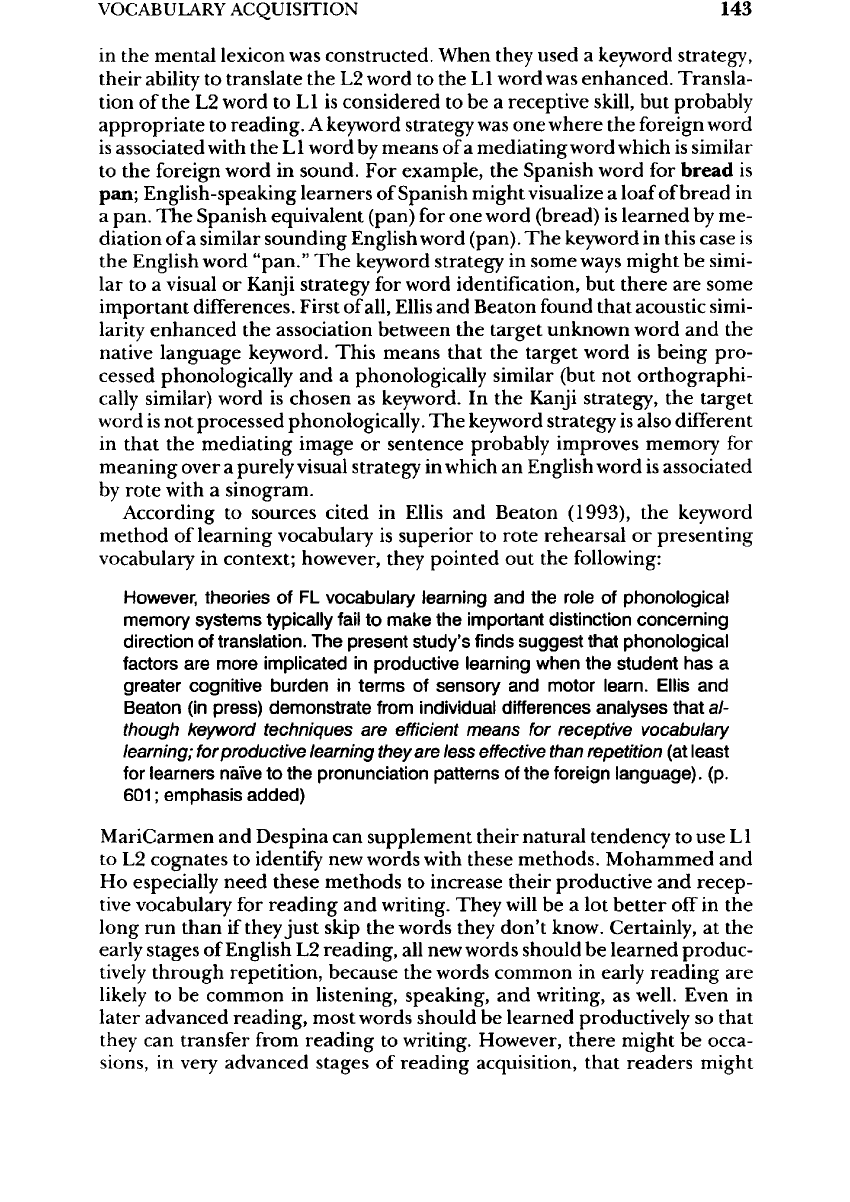
VOCABULARY
ACQUISITION
143
in
the
mental lexicon
was
constructed. When they used
a
keyword strategy,
their ability
to
translate
the L2
word
to the
LI
word
was
enhanced. Transla-
tion
of the L2
word
to
LI
is
considered
to be a
receptive skill,
but
probably
appropriate
to
reading.
A
keyword strategy
was
one
where
the
foreign word
is
associated with
the
LI
word
by
means
of a
mediating word which
is
similar
to the
foreign word
in
sound.
For
example,
the
Spanish word
for
bread
is
pan; English-speaking learners
of
Spanish might
visualize
a
loaf
of
bread
in
a
pan.
The
Spanish equivalent (pan)
for one
word (bread)
is
learned
by me-
diation
of a
similar sounding English word (pan).
The
keyword
in
this case
is
the
English word
"pan."
The
keyword strategy
in
some
ways
might
be
simi-
lar
to a
visual
or
Kanji
strategy
for
word identification,
but
there
are
some
important differences. First
of
all,
Ellis
and
Beaton found that acoustic simi-
larity
enhanced
the
association between
the
target unknown word
and the
native
language keyword.
This
means that
the
target word
is
being pro-
cessed phonologically
and a
phonologically similar (but
not
orthographi-
cally
similar) word
is
chosen
as
keyword.
In the
Kanji
strategy,
the
target
word
is not
processed
phonologically.
The
keyword strategy
is
also
different
in
that
the
mediating image
or
sentence probably improves memory
for
meaning over
a
purely visual strategy
in
which
an
English word
is
associated
by
rote with
a
sinogram.
According
to
sources cited
in
Ellis
and
Beaton (1993),
the
keyword
method
of
learning vocabulary
is
superior
to
rote rehearsal
or
presenting
vocabulary
in
context; however, they pointed
out the
following:
However,
theories
of FL
vocabulary
learning
and the
role
of
phonological
memory systems
typically
fail
to
make
the
important
distinction
concerning
direction
of
translation.
The
present study's
finds
suggest
that
phonological
factors
are
more
implicated
in
productive
learning
when
the
student
has a
greater
cognitive
burden
in
terms
of
sensory
and
motor learn.
Ellis
and
Beaton
(in
press) demonstrate from
individual
differences analyses
that
al-
though
keyword techniques
are
efficient
means
for
receptive
vocabulary
learning;
for
productive
learning
they
are
less
effective
than
repetition
(at
least
for
learners
naive
to the
pronunciation
patterns
of the
foreign
language),
(p.
601;
emphasis added)
MariCarmen
and
Despina
can
supplement
their
natural tendency
to use
LI
to L2
cognates
to
identify
new
words with these methods. Mohammed
and
Ho
especially need these methods
to
increase their productive
and
recep-
tive
vocabulary
for
reading
and
writing. They
will
be a lot
better
off
in the
long
run
than
if
they
just skip
the
words they don't know. Certainly,
at the
early
stages
of
English
L2
reading,
all new
words should
be
learned produc-
tively
through repetition, because
the
words common
in
early reading
are
likely
to be
common
in
listening, speaking,
and
writing,
as
well. Even
in
later advanced reading, most words should
be
learned productively
so
that
they
can
transfer
from
reading
to
writing. However, there might
be
occa-
sions,
in
very advanced stages
of
reading acquisition, that readers might
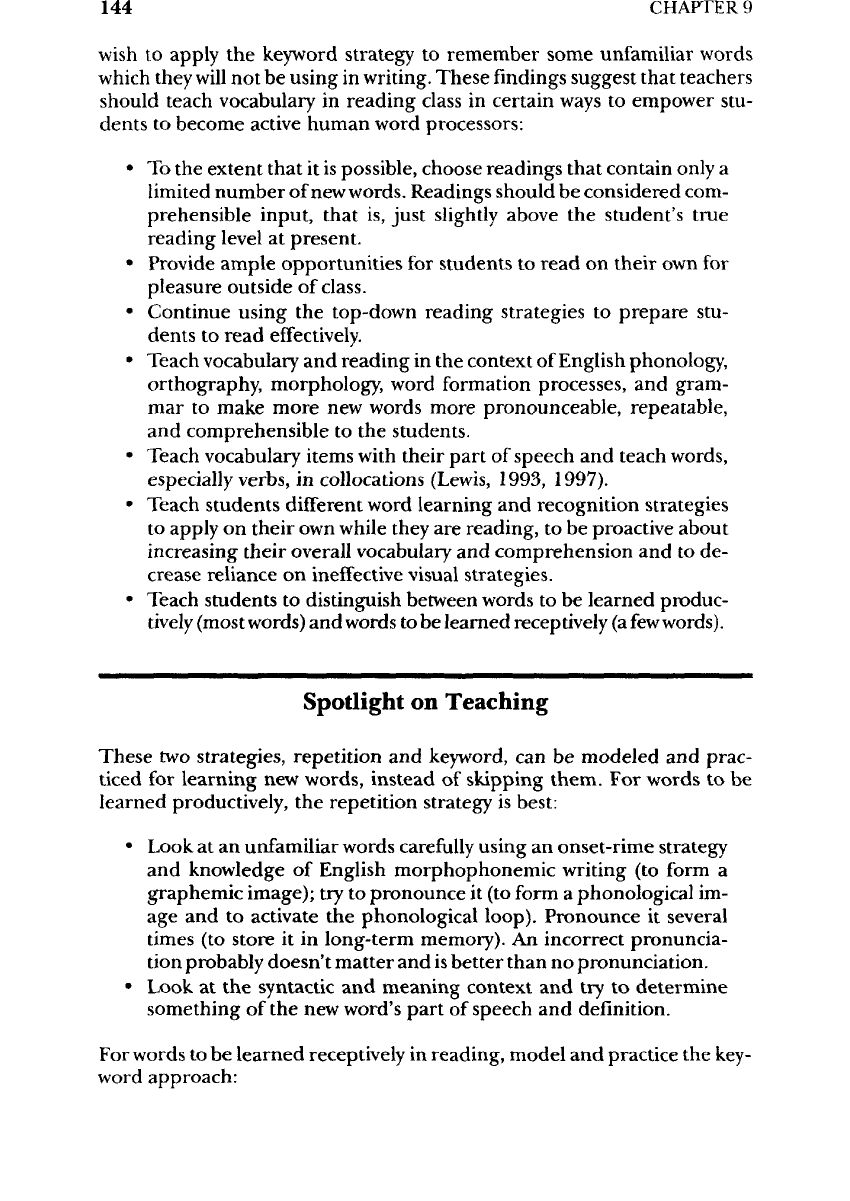
144
CHAPTER
9
wish
to
apply
the
keyword strategy
to
remember some unfamiliar words
which
they
will
not be
using
in
writing.
These
findings
suggest that teachers
should
teach vocabulary
in
reading
class
in
certain
ways
to
empower stu-
dents
to
become active human word processors:
To the
extent that
it is
possible, choose readings that contain
only
a
limited
number
of new
words. Readings should
be
considered com-
prehensible input, that
is,
just
slightly
above
the
student's true
reading level
at
present.
Provide ample
opportunities
for
students
to
read
on
their
own for
pleasure
outside
of
class.
Continue using
the
top-down reading strategies
to
prepare stu-
dents
to
read
effectively.
Teach vocabulary
and
reading
in the
context
of
English phonology,
orthography,
morphology, word
formation
processes,
and
gram-
mar to
make more
new
words more pronounceable, repeatable,
and
comprehensible
to the
students.
Teach vocabulary items
with
their part
of
speech
and
teach words,
especially
verbs,
in
collocations
(Lewis,
1993, 1997).
Teach students
different
word learning
and
recognition strategies
to
apply
on
their
own
while they
are
reading,
to be
proactive about
increasing their overall vocabulary
and
comprehension
and to de-
crease reliance
on
ineffective
visual strategies.
Teach students
to
distinguish between words
to be
learned produc-
tively
(most words)
and
words
to
be
learned
receptively
(a
few
words).
Spotlight
on
Teaching
These
two
strategies, repetition
and
keyword,
can be
modeled
and
prac-
ticed
for
learning
new
words,
instead
of
skipping them.
For
words
to be
learned productively,
the
repetition strategy
is
best:
Look
at an
unfamiliar words
carefully
using
an
onset-rime strategy
and
knowledge
of
English morphophonemic writing
(to
form
a
graphemic image);
try to
pronounce
it (to
form
a
phonological
im-
age
and to
activate
the
phonological loop). Pronounce
it
several
times
(to
store
it in
long-term memory).
An
incorrect pronuncia-
tion
probably doesn't matter
and is
better than
no
pronunciation.
Look
at the
syntactic
and
meaning context
and try to
determine
something
of the new
word's part
of
speech
and
definition.
For
words
to be
learned
receptively
in
reading, model
and
practice
the
key-
word
approach:
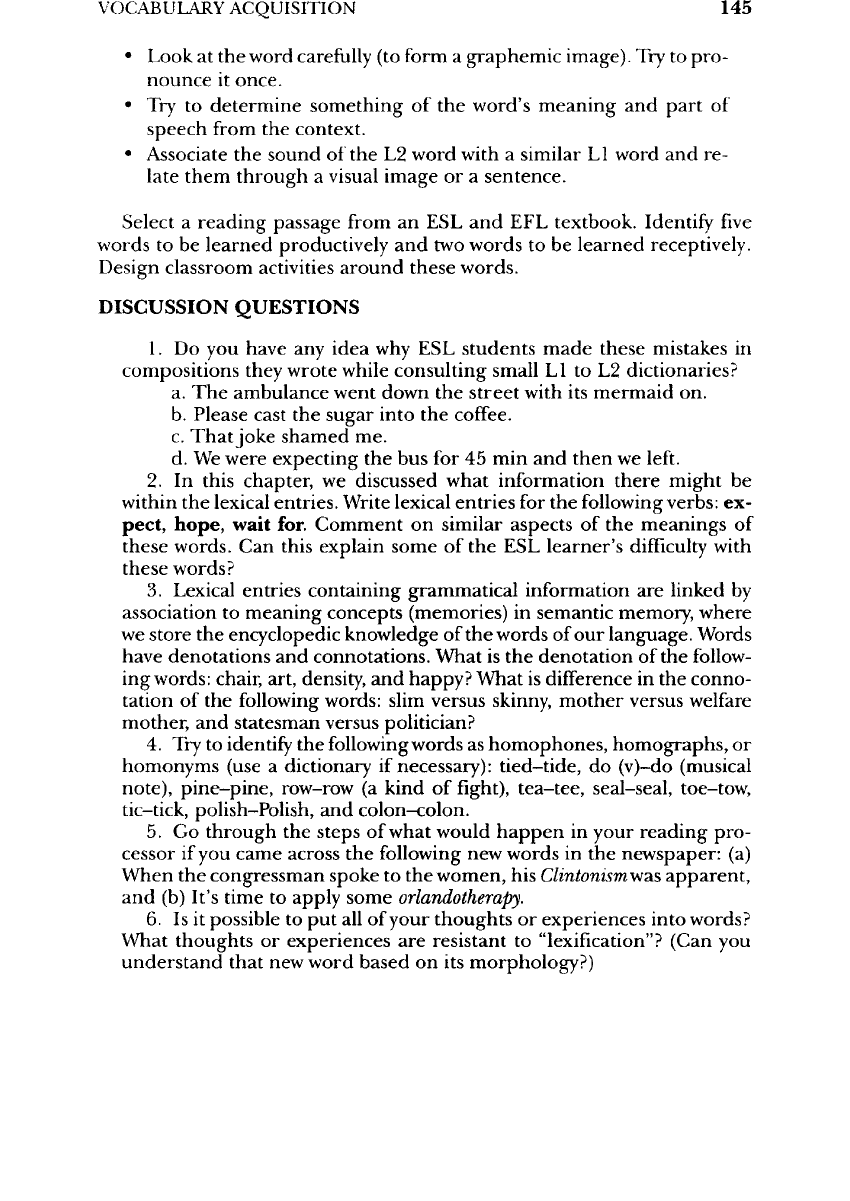
VOCABULARY
ACQUISITION
145
Look
at the
word
carefully
(to
form
a
graphemic
image).
Try to
pro-
nounce
it
once.
Try to
determine something
of the
word's meaning
and
part
of
speech
from
the
context.
Associate
the
sound
of the L2
word with
a
similar
LI
word
and re-
late
them through
a
visual
image
or a
sentence.
Select
a
reading passage
from
an ESL and EFL
textbook.
Identify
five
words
to be
learned productively
and two
words
to be
learned receptively.
Design
classroom
activities
around these words.
DISCUSSION QUESTIONS
1.
Do you
have
any
idea
why ESL
students made these mistakes
in
compositions
they wrote while consulting small
LI
to L2
dictionaries?
a. The
ambulance went down
the
street
with
its
mermaid
on.
b.
Please cast
the
sugar into
the
coffee.
c.
That
joke
shamed
me.
d. We
were expecting
the bus for 45 min and
then
we
left.
2.
In
this chapter,
we
discussed what information
there
might
be
within
the
lexical entries. Write lexical entries
for the
following
verbs:
ex-
pect,
hope,
wait for. Comment
on
similar aspects
of the
meanings
of
these words.
Can
this explain some
of the ESL
learner's
difficulty
with
these words?
3.
Lexical entries containing grammatical information
are
linked
by
association
to
meaning concepts (memories)
in
semantic memory, where
we
store
the
encyclopedic knowledge
of the
words
of our
language. Words
have
denotations
and
connotations. What
is the
denotation
of the
follow-
ing
words: chair, art, density,
and
happy? What
is
difference
in the
conno-
tation
of the
following
words: slim versus skinny, mother versus
welfare
mother,
and
statesman versus politician?
4. Try to
identify
the
following
words
as
homophones, homographs,
or
homonyms (use
a
dictionary
if
necessary):
tied-tide,
do
(v)-do
(musical
note),
pine-pine,
row-row
(a
kind
of fight),
tea-tee,
seal-seal,
toe-tow,
tic-tick, polish-Polish,
and
colon-colon.
5.
Go
through
the
steps
of
what would
happen
in
your reading pro-
cessor
if you
came across
the
following
new
words
in the
newspaper:
(a)
When
the
congressman spoke
to the
women,
his
Clintonism-was
apparent,
and (b)
It's time
to
apply some
orlandotherapy.
6. Is it
possible
to put all of
your thoughts
or
experiences into words?
What
thoughts
or
experiences
are
resistant
to
"lexification"?
(Can
you
understand that
new
word based
on its
morphology?)

Chapter
10
Getting
to the
Bottom
of
English
L2
Reading
This book
has
explored some
of the
exciting
new
research
in the
area
of
English
LI
and
L2
reading
and
offered
a new
concept
of the
proficient
ESL
and
EFL
reader:
that
of an
expert
decision-making
and
problem-solving
mind
that uses extensive knowledge
of
language
and the
world,
effective
cognitive
comprehension strategies,
and
quick automatic
low-level
process-
ing
strategies
to
interact
with
the
text
efficiently.
The
discussion
in
this book
has
aimed specifically
at
getting
to the
bottom
of the
reading
processor,
that
is,
reinforcing
and
strengthening
our
understanding
and
appreciation
for
the
details
of
low-level knowledge
and
processing strategies
our
students
need
to
read
in
English.
This
focus, however,
doesn't
mean that higher-level knowledge
of the
world
and
top-down processing strategies
are
less important.
In
fact,
the
bottom
of the
reading processor serves
the top
because
the
more
efficiently
and
"quietly"
the
bottom
functions,
the
more attention there
will
be for
higher-level processing
of
meaning, implications, outside references,
and
so
on.
Language processing
skills
are one
subcomponent
of
more general
cognitive
processing; linguistic knowledge
is
just
one
area
of the
complete
knowledge
about
the
world, culture,
or
personal memories
of the
reader.
This
is a
more
balanced
and
integrated
view
of
reading, worthy
of the
name
"whole
language."
The
balanced integrated perspective
offers
a
different
picture
of
what
"guessing" involves: split-second decisions based
on
accurate perception,
reasoning abilities,
and
stored knowledge.
To
make good guesses,
an ESL
and
EFL
reader
must pass through
the
various stages
of
acquisition
posited
by
Chall
(1983)
and
Ehri (1998). Although they
can be
assisted
through
early
to
advanced reading
by
teachers
who get
them started
and
guide them
146
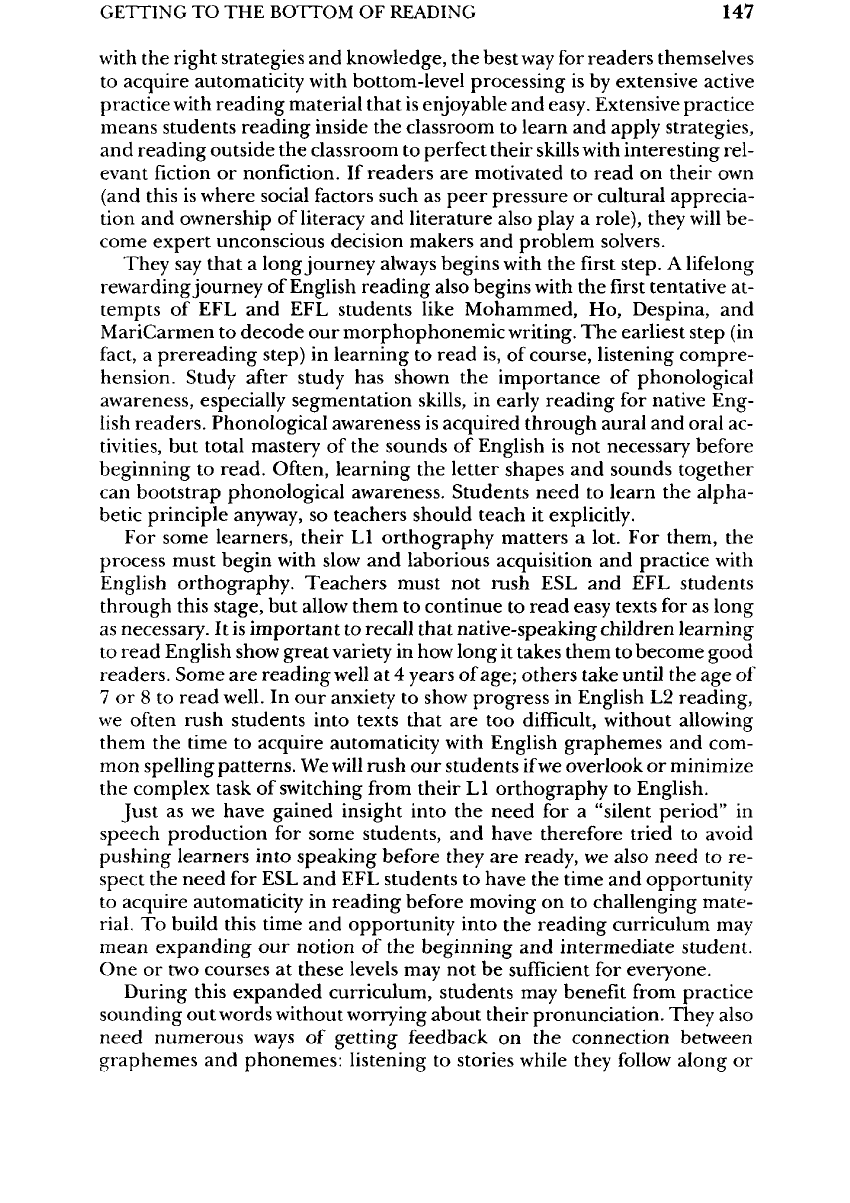
GETTING
TO THE
BOTTOM
OF
READING
147
with
the
right strategies
and
knowledge,
the
best
way
for
readers themselves
to
acquire
automaticity
with
bottom-level processing
is by
extensive active
practice with reading material that
is
enjoyable
and
easy. Extensive practice
means students reading inside
the
classroom
to
learn
and
apply strategies,
and
reading outside
the
classroom
to
perfect their skills
with
interesting rel-
evant
fiction
or
nonfiction.
If
readers
are
motivated
to
read
on
their
own
(and
this
is
where social factors such
as
peer
pressure
or
cultural apprecia-
tion
and
ownership
of
literacy
and
literature also play
a
role), they
will
be-
come expert unconscious decision makers
and
problem solvers.
They
say
that
a
long journey
always
begins with
the first
step.
A
lifelong
rewarding
journey
of
English reading also begins
with
the
first
tentative
at-
tempts
of EFL and EFL
students like Mohammed,
Ho,
Despina,
and
MariCarmen
to
decode
our
morphophonemic writing.
The
earliest step
(in
fact,
a
prereading step)
in
learning
to
read
is, of
course, listening compre-
hension. Study after study
has
shown
the
importance
of
phonological
awareness, especially segmentation skills,
in
early
reading
for
native Eng-
lish
readers. Phonological awareness
is
acquired through aural
and
oral
ac-
tivities,
but
total mastery
of the
sounds
of
English
is not
necessary before
beginning
to
read.
Often, learning
the
letter shapes
and
sounds together
can
bootstrap
phonological
awareness. Students
need
to
learn
the
alpha-
betic
principle anyway,
so
teachers should teach
it
explicitly.
For
some learners, their
LI
orthography matters
a
lot.
For
them,
the
process must begin with
slow
and
laborious acquisition
and
practice
with
English
orthography.
Teachers
must
not
rush
ESL and EFL
students
through this stage,
but
allow them
to
continue
to
read easy texts
for as
long
as
necessary.
It is
important
to
recall that native-speaking children learning
to
read English show great variety
in how
long
it
takes them
to
become good
readers. Some
are
reading
well
at 4
years
of
age;
others
take until
the age of
7
or 8 to
read well.
In our
anxiety
to
show progress
in
English
L2
reading,
we
often rush students into texts that
are too
difficult,
without allowing
them
the
time
to
acquire automaticity with English graphemes
and
com-
mon
spelling
patterns.
We
will rush
our
students
if
we
overlook
or
minimize
the
complex task
of
switching from their
LI
orthography
to
English.
Just
as we
have gained insight into
the
need
for a
"silent period"
in
speech production
for
some students,
and
have therefore tried
to
avoid
pushing
learners
into speaking before they
are
ready,
we
also
need
to re-
spect
the
need
for ESL and EFL
students
to
have
the
time
and
opportunity
to
acquire automaticity
in
reading before moving
on to
challenging mate-
rial.
To
build this time
and
opportunity into
the
reading curriculum
may
mean
expanding
our
notion
of the
beginning
and
intermediate
student.
One or two
courses
at
these levels
may not be
sufficient
for
everyone.
During this expanded curriculum, students
may
benefit
from
practice
sounding
out
words without worrying about their pronunciation. They also
need numerous ways
of
getting
feedback
on the
connection between
graphemes
and
phonemes: listening
to
stories while they
follow
along
or
